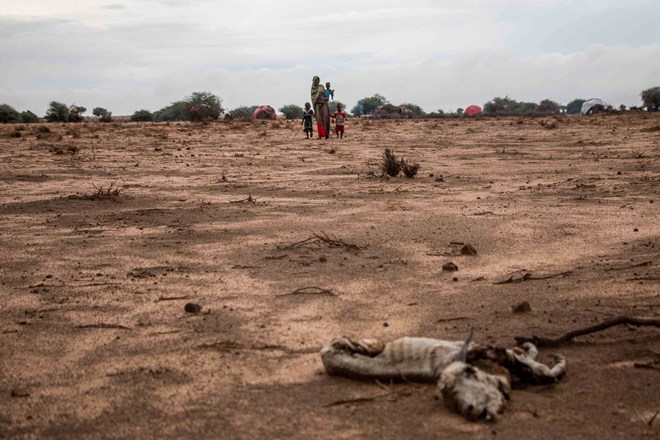
Friday January 20, 2017

Until he breathed his last, Mr Omar Hassan led a decent life as pastoralist in Somalia's Galgadud region. He was comfortable, earning and eating his daily bread.
But with diminishing water and pasture in the Horn of Africa country, Mr Omar's fortunes started dwindling. His livestock couldn't take the heat, died one by one leaving him a pauper. In November last year, Mr Hassan was left with an empty kraal after his livestock died. He committed suicide.
“Omar Hassan first suffered some kind of depression,” a relative told the media mid-November last year. “Unfortunately, he could not regain full composure as his animals died one-by-one,” he added.
Some say that at least two more people are known to have committed suicide after witnessing the deaths of their animals due to lack of pasture and water.
Although the drought affects all kinds of communities, the pastoralists, who chiefly depend on rain water are most affected.
In March last year, the United Nations Office for the Coordination of Humanitarian Affairs (UN-OCHA) declared that severe drought exacerbated by the El Niño phenomenon had hit parts of Puntland and Somaliland, two northern regions of Somalia.
Failure of rains over the past two years has caused the severe drought, affecting thousands in the Horn of Africa country.
“Worsening drought conditions across the country have left hundreds of thousands of Somalis facing severe food and water shortages,” UN-OCHA affirmed.
According to the UN, some 5 million people (40 per cent of the population) are in need of humanitarian assistance while more than 1.1 million of these in “crisis” and “emergency’.
Pastures
Since last year, things have worsened, especially after the failure of the last Dayr (short rains) with clouds disappearing towards the end of the year.
As a result, most Somali regions from Sanaag in the northwest to Gedo in the south, millions of people and their livestock have been on a desperate move in search.
A legislator from Jubaland Administration, Mohamed Da’uud who visited Gedo region in November 2016 expressed shock. “Anyone with resources must help,” said Mr Da’uud.
“People in Bardere district, which is about 341 km south of Mogadishu, are harshly affected by the serious shortage of food, water and medication,” he added, calling on the federal government, the local Interim Jubaland Authority and the international community to help.
The Puntland Authority, in North eastern Somalia has set up a team to tackle the drought in its five regions.
Committee Chairman, Abdullahi Hashi alias Qoob-deero, the authority’s deputy minister of internal affairs, described the situation in Bari, Mudug, Nugal and parts of Sool and Sanaag as dire.
Late last December, Hashi revealed that herders are losing a large number of their livestock, including cattle, goats and camels.
In a bid to save lives, the Puntland drought committee has initiated a water distribution operation. Mr Hashi recently told the media that he has been getting horrifying stories from the rural areas.
“Committee members who visited the drought-hit areas have seen enormous sufferings including 2 years old girl who had no water for over 24 hours,” said Hashi. “They had also met a lactating mother, who had gone without food or drinks for 36 hours.”
In Somaliland, the drought has been equally devastating, particularly in the eastern regions.
“The drought is fast spreading,” said Osman Dhere, an elder who has moved his family from Sanaag in the eastern regions to Wajaale, a border district between Somaliland and Ethiopia.
Across the Somali regions, water sources are far in between. Sometimes, pastoralists have to walk for over 100 kilometres to get water.
“We have lost most of our animals. The remaining need feed and water as the land can no longer provide pasture,” Dhere added.
Traditional elders in Somaliland and Puntland have launched a fundraising campaign to support to nomads who have lost their livestock. “One (US) dollar may save a life,” declared a member of drought committee in Somaliland.
The federal government of Somalia too appointed recently a drought committee lead by Deputy Prime Minister Mohamed Omar Arte. Committee members have been mobilising resources.
Worsening
Deputy PM Arte addressed his appeal for the drought victims to fellow Somalis, especially the business community and Somalia’s international partners.
Already, help seems forthcoming. The United Nations has a humanitarian response plan for Somalia.
“The 2017 Humanitarian Response Plan outlines the humanitarian situation and priorities for response throughout the country,” announced Shabelle, an independent media in Mogadishu last week.
Developed within the framework of the three-year humanitarian strategy for Somalia for 2016-2018, the response plan covering 12 months aim to save lives, ensure the protection of the most vulnerable, strengthen resilience, support the provision of basic services and enable durable solutions through a coordinated, comprehensive approach.
“Throughout the implementation of this plan, the humanitarian community will embed the principle of the centrality of protection by means of a humanitarian response to protect the most vulnerable groups,” OCHA reiterated.
Crisis
Other reports indicate that the drought equally affects arid and semiarid zones in Kenya and Ethiopia, both countries neighbouring Somalia to the west and south.
Residents reckon that things can turn worse as the country heads towards the jilaal (dry) season, January-April.
“The levels of human suffering in Somalia, triggered by protracted conflict, seasonal shocks and disease outbreaks are typically hard to bear, but the impact of this drought represents a threat of a different scale and magnitude,” said Peter de Clercq, the UN’s humanitarian co-coordinator for Somalia
He further pointed out that 5 million of the 12.3 million people were in need of assistance.
“Many of the indicators that preceded a 2011 famine, in which 260,000 people died, had reappeared and were deteriorating faster than previously expected,” asserted the UN official who said his organisation needs $864 million to deal with the crisis.